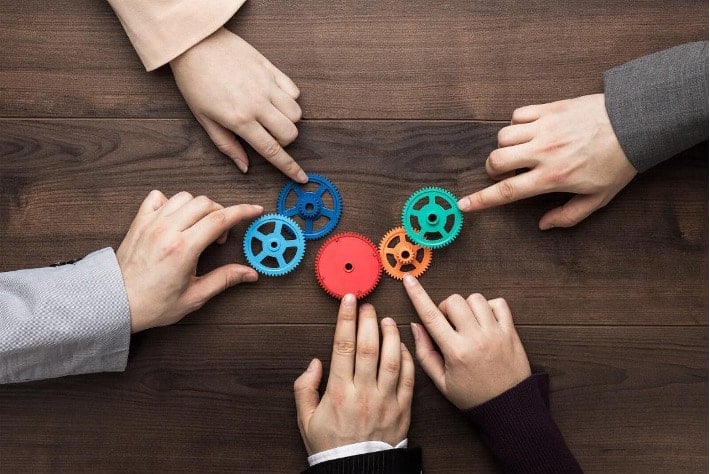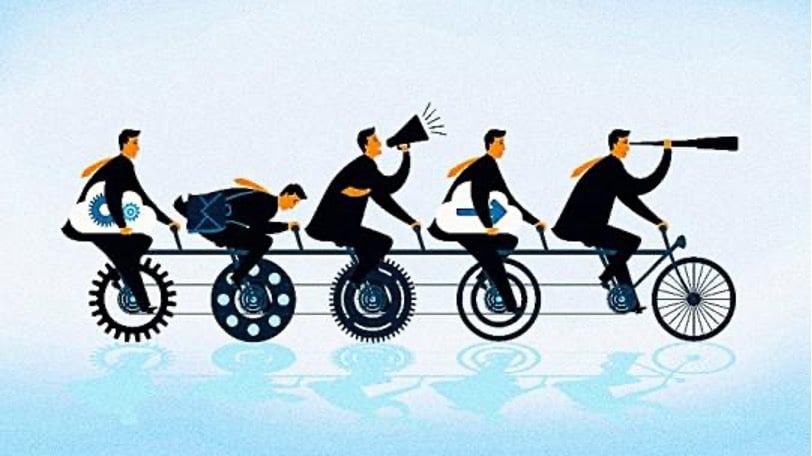27 de April de 2023
Mastering the Dynamic Effort Method Within Your Team
Team sports make up a large part of the overall number of sports played in society. In fact, children and teenagers often focus on team sports such as soccer, basketball, volleyball, or handball, leaving aside other more individual sports such as athletics, swimming, tennis, or any contact sport. However, what children are not able to understand is that being part of a team has certain benefits and detriments. In fact, the study of being part of a team has been researched for decades because of the effect it can have on performance.
One of the greatest researchers in this field was Kurt Lewin, founder of social psychology and specialist in group psychology. Kurt Lewin based part of his research on understanding how group cohesion can promote the performance of athletes. In fact, there is a theory called “Dynamic Effort Method” that focuses on improving a group’s performance. Considering that a sports team can benefit from this method, in today’s post we are going to focus on defining what the dynamic effort method is and expose the variables that can make a sports team improve with its application.
For this purpose, we are going to review the literature obtaining the key points of its application and giving recommendations on how it can be applied in a sports team. Before we begin, we must emphasize that this method requires a qualified psychologist to be able to correctly analyze the development of the group. In high competition it is normal to have sports psychologists and specialized psychologists, but it is not so common in amateur sport or school sport, so be aware that this post is based only on recommendations.
Group Cohesiveness as The Dynamic Effort Method’s Key

Recent research has shown that variables which determine group cohesiveness are positively associated with team success (1). This fact shows that group interventions make groups more productive as well as having a better performance. In addition, psychology-focused tools have been developed over time to assess athletes’ and coaches’ perceptions of group cohesion. These tools are fundamental to measuring and understanding team success and developing effective interventions to improve sport performance.
The dynamic effort method is a technique used to improve team performance in any type of activity. This method is based on the idea that, to achieve success, working together to overcome obstacles and to reach goals is a necessary requirement for every team member. In fact, a systematic review with meta-analysis studied the relationship between team cohesiveness and performance in sports. The results of that study showed that there is a direct and significant relationship between team cohesion and performance, i.e., teams with higher cohesion perform better compared to teams with lower cohesion. However, the authors also emphasize that there are other factors that can also influence team performance.

An interesting fact was that the authors also found that the relationship is stronger in invasive team sports (e.g., soccer) compared to non-invasive team sports (e.g., volleyball). These results help us define in which team sport it is most important to work on cohesion and help us practitioners focus on different strategies to improve that group cohesion. The following are a series of characteristics to encourage when we want to improve cohesion:
- Improve collaboration and communication.
- Encourage open communication and positive feedback as they were positively related to team cohesion in youth basketball players (2).
- Teach social skills such as conflict resolution and cooperation.
- Establish shared goals and focus on team success rather than individual success.
What Should be Done to Apply the Dynamic Effort Method?
First, I would like to remind you that the dynamic effort method is a psychological theory that explains how the presence of other people in a task can have a positive effect on the performance of the task at hand. However, we should not leave all the importance of success in this relationship within the group, if there are other aspects such as the complexity of the task or the opponent we face in the performance; these are also important. But the million-dollar question: What do we do to apply this method? We can follow these steps:
Identify Common Goals
The first step in applying the dynamic effort method is to set common objectives for all individuals in the group. As we have always said, the objectives must be realistic and must lead all the members of the group in the same direction. The coach oversees the objectives, but from here we recommend that you ask the question in an open way: What goal do you think we have as a team? This encourages the participation of all members of the group. All members should be given a voice, so that no one is excluded. We should try to avoid cliques and confrontations.
Set Roles
There isn’t a better feeling than belonging to a group where each member has a clear role, and who is comfortable with that role. Each team member should know their role and responsibilities within the team. It is important that each person feels valued and knows that their work is essential for the team’s success. These roles can be in the sports area or also within the social environment that is created in the team. This brings us to the next point.

Encourage Collaboration & Social Relations in the Group
We understand that all members of the group will collaborate with the team tasks. However, this is not so common. Within each group there are better and worse social relationships, and it is difficult for everyone to be “friends”. However, as coaches we must make sure that this happens. Encouraging activities between people who are not remarkably close can help in a better application of the dynamic method. Let’s use an easy-to-understand example.
When there’s a new soccer player in a team, he usually does all the activities with athletes of the same nationality and sometimes gets “separated” from the group. A well-known case was that of Gareth Bale who, not knowing the language and only meeting with English-speaking people, was somewhat separated from the group. In fact, his performance has not been particularly good in the Spanish team, and this may be one of the reasons. It is essential that team members collaborate with each other and share information. Communication is the key to the team’s success.
What Are the Benefits of The Dynamic Effort Method?

We have seen the characteristics that any application of the dynamic effort method must possess, but we do not know its true potential. First, we must clarify that performance isn’t linked to this method. Thus, it can be applied performance is maintains and won’t improve. However, in the long term it is a way to join your group. In fact, we could say that Pep Guardiola is one of the coaches who, whether he wanted to or not, used the dynamic effort method in a particularly effective way. The dynamic effort method can offer certain benefits for the teams that apply it. Among all the possible benefits, we wanted to highlight the following:
Enhances Motivation & Has Impact on Performance
If we manage to apply this method correctly, we will be able to improve the motivation of the athletes. To do this, each athlete must feel that they are part of the method. If, for example, a group of athletes underestimates the effect of this method, their motivation may not increase, or their performance may not improve. On the other hand, if the team leaders are aware of the importance of a good application will favor the collaboration of the rest of the players. There is enough evidence to confirm that this method improves performance if applied thoroughly, so believe it and apply it with your athletes!
Identifies Areas of Improvement and Strengthens Interpersonal Relationships
Another positive aspect of applying this method is the identification of areas for improvement within the team. By periodically evaluating the team’s progress, we can identify areas for improvement and take steps to correct them. In addition, we identify the positive points of our group and can encourage them. For example, if we evaluate our team and we see that communication between players off the field needs to be improved, but we see that on the field in the days leading up to the game and during training camps the team’s communication is fabulous, we should improve one and encourage the other. By encouraging collaboration and teamwork, the dynamic effort method can strengthen interpersonal relationships within the team.
Who Can Use This Method?
The dynamic effort method is conducted to collective sports teams. However, this method can be applied in diverse types of groups. Today we are going to give you examples of where this methodology can also be applied. Let us start with the sports team. For example, a handball team can define its objectives and establish roles for each player, encourage communication and collaboration among team members, and periodically evaluate their progress.
An educational team, i.e., the group of teachers that make up a faculty or a work group, can apply the dynamic effort method to improve their way of working and their professional development. And not only that, but study teams also preparing for a mathematical competition can benefit from this method.
And, finally, any type of corporate work group. That is, every department within a company has directors, assistant directors, specialists, managers, and technicians. They all must pull in the same direction and make the work as professional as possible. For example, a sales team can apply the dynamic effort method, or a mechanical workshop as well.
Conclusion
The dynamic effort method is an effective technique for improving team performance in any type of activity. By following the steps, we have presented in this informative post, teams can foster collaboration, motivation, and active participation of each member, which can significantly improve their performance. In addition, the application of the dynamic effort method can strengthen interpersonal relationships within the team and promote a positive and constructive work environment.
It is important to remember that the dynamic effort method requires time and effort for its effective application, as well as for its periodic evaluation and continuous improvement. However, the positive results that can be achieved are valuable and can have a lasting impact on the team and the individuals within it.
In summary, the dynamic effort method is a useful technique for improving team performance and achieving team objectives. By following the steps, we have presented in this informative post and applying the recommendations of experts in the field, teams can strengthen their collaboration, communication, and motivation, and achieve outstanding results in any activity in which they perform.
Unai Adrián Pérez de Arrilucea Le Floc’h
References
- Tenenbaum GE, Eklund RC, Kamata AE. Measurement in sport and exercise psychology: Human Kinetics; 2012.
- Jowett S, Chaundy V. An investigation into the impact of coach leadership and coach-athlete relationship on group cohesion. Group Dynamics: Theory, Research, and Practice. 2004;8(4):302.

